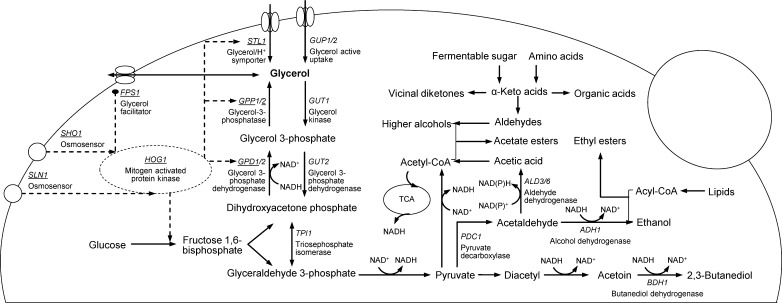Fig. 1.
Glycerol biosynthesis in respond to osmotic stress and redox statue and the interrelationship with yeast-derived aroma compounds in S. cerevisiae NADH: reduced form of nicotinamide adenine dinucleotide; TCA: tricarboxylic acid cycle; Acety-CoA: acetyl-coenzyme A; Acyl-CoA: acyl-coenzyme A; Underline genes: the expressions regulated by osmotic stress; Solid line: metabolic reaction(s); Dash line: schematic osmoregulatory signal transduction cascade (HOG signaling pathway); Many reactions, isogenes, ATP, Pi, CO2 and CoA are omitted in the figure for clarity. The organoleptic impression of the aroma-active metabolites in associate with glycerol sensory contributions and yield optimizations (Briggs et al. 2004): vicinal diketones: diacetyl (buttery), acetoin (musty), 2,3-butanediol (slightly bitter, relative neutral); Organic acids: acetic, malic, lactic and citric acids (sour), succinic acid (bitter-salty); Aldehydes: acetaldehyde (grassy), 3-methylbutanal (malty, chocolate-like), 2-methylbutanal (malty, cheesy); Higher alcohols: octenol (earthy, mushroom-like), 2-ethylhexanol (mushroom-like, sweet fruity), β-phenylethyl alcohol (rosy, honey-like); Acetate esters: ethyl acetate (solvent-like), isoamyl acetate or 3-methyl butyl acetate (banana-like), β-phenyl ethyl acetate (rosy); Fatty acid ethyl ester: ethyl hexanoate (apple-like)

